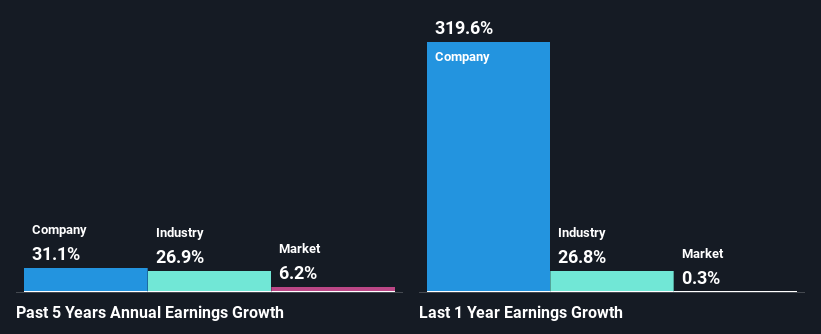Is Cathay Pacific Airways Limited's (HKG:293) Stock's Recent Performance A Reflection Of Its Financial Health?

Most readers would already know that Cathay Pacific Airways' (HKG:293) stock increased by 3.7% over the past week. Given that the market rewards strong financials in the long-term, we wonder if that is the case in this instance. In this article, we decided to focus on Cathay Pacific Airways' ROE.
Return on Equity or ROE is a test of how effectively a company is growing its value and managing investors’ money. In short, ROE shows the profit each dollar generates with respect to its shareholder investments.
View our latest analysis for Cathay Pacific Airways
How Do You Calculate Return On Equity?
Return on equity can be calculated by using the formula:
Return on Equity = Net Profit (from continuing operations) ÷ Shareholders' Equity
So, based on the above formula, the ROE for Cathay Pacific Airways is:
15% = HK$9.1b ÷ HK$61b (Based on the trailing twelve months to June 2024).
The 'return' is the income the business earned over the last year. Another way to think of that is that for every HK$1 worth of equity, the company was able to earn HK$0.15 in profit.
What Has ROE Got To Do With Earnings Growth?
So far, we've learned that ROE is a measure of a company's profitability. Based on how much of its profits the company chooses to reinvest or "retain", we are then able to evaluate a company's future ability to generate profits. Assuming all else is equal, companies that have both a higher return on equity and higher profit retention are usually the ones that have a higher growth rate when compared to companies that don't have the same features.
Cathay Pacific Airways' Earnings Growth And 15% ROE
At first glance, Cathay Pacific Airways seems to have a decent ROE. Even so, when compared with the average industry ROE of 19%, we aren't very excited. However, we are pleased to see the impressive 31% net income growth reported by Cathay Pacific Airways over the past five years. We believe that there might be other aspects that are positively influencing the company's earnings growth. For example, it is possible that the company's management has made some good strategic decisions, or that the company has a low payout ratio. Bear in mind, the company does have a respectable ROE. It is just that the industry ROE is higher. So this also does lend some color to the high earnings growth seen by the company.
As a next step, we compared Cathay Pacific Airways' net income growth with the industry and found that the company has a similar growth figure when compared with the industry average growth rate of 27% in the same period.

The basis for attaching value to a company is, to a great extent, tied to its earnings growth. It’s important for an investor to know whether the market has priced in the company's expected earnings growth (or decline). By doing so, they will have an idea if the stock is headed into clear blue waters or if swampy waters await. One good indicator of expected earnings growth is the P/E ratio which determines the price the market is willing to pay for a stock based on its earnings prospects. So, you may want to check if Cathay Pacific Airways is trading on a high P/E or a low P/E, relative to its industry.
Is Cathay Pacific Airways Using Its Retained Earnings Effectively?
Cathay Pacific Airways' three-year median payout ratio is a pretty moderate 39%, meaning the company retains 61% of its income. So it seems that Cathay Pacific Airways is reinvesting efficiently in a way that it sees impressive growth in its earnings (discussed above) and pays a dividend that's well covered.
Additionally, Cathay Pacific Airways has paid dividends over a period of at least ten years which means that the company is pretty serious about sharing its profits with shareholders. Our latest analyst data shows that the future payout ratio of the company is expected to rise to 48% over the next three years. Consequently, the higher expected payout ratio explains the decline in the company's expected ROE (to 11%) over the same period.
Conclusion
In total, we are pretty happy with Cathay Pacific Airways' performance. Specifically, we like that it has been reinvesting a high portion of its profits at a moderate rate of return, resulting in earnings expansion. That being so, according to the latest industry analyst forecasts, the company's earnings are expected to shrink in the future. To know more about the company's future earnings growth forecasts take a look at this free report on analyst forecasts for the company to find out more.
New: AI Stock Screener & Alerts
Our new AI Stock Screener scans the market every day to uncover opportunities.
• Dividend Powerhouses (3%+ Yield)
• Undervalued Small Caps with Insider Buying
• High growth Tech and AI Companies
Or build your own from over 50 metrics.
Have feedback on this article? Concerned about the content? Get in touch with us directly. Alternatively, email editorial-team (at) simplywallst.com.
This article by Simply Wall St is general in nature. We provide commentary based on historical data and analyst forecasts only using an unbiased methodology and our articles are not intended to be financial advice. It does not constitute a recommendation to buy or sell any stock, and does not take account of your objectives, or your financial situation. We aim to bring you long-term focused analysis driven by fundamental data. Note that our analysis may not factor in the latest price-sensitive company announcements or qualitative material. Simply Wall St has no position in any stocks mentioned.
About SEHK:293
Cathay Pacific Airways
Offers international passenger and air cargo transportation services.
Undervalued with solid track record and pays a dividend.
Similar Companies
Market Insights
Community Narratives




